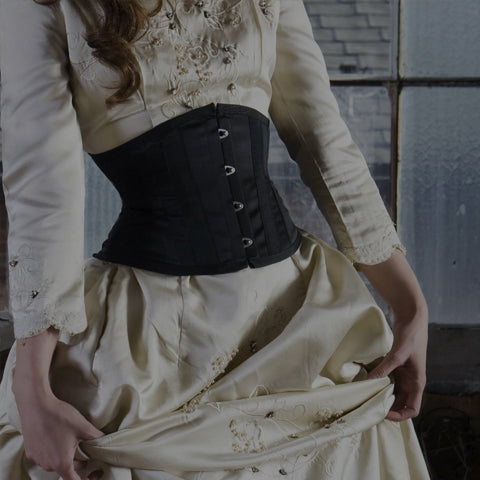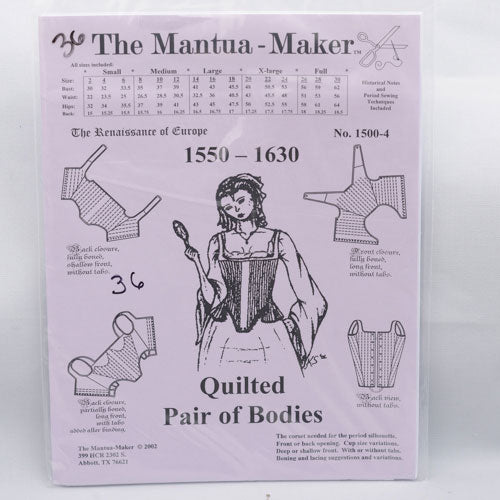Elizabethan Corset – Pair of BodiesPattern # 00-PATTERN-36 By The Mantua Maker
Cut out your pattern pieces, you will need a shell and a lining layer. Be very careful where you cut, there are different lines depending on whether you have a front opening corset or back opening corset. There are also lines to accommodate various cup sizes so be sure to mark your cutting lines before you cut the pattern. Draw the casing lines onto the right side of the lining layer of fabric, having first marked on seam allowances all around each piece. It is important to draw the lines on the right side of fabric, so that you'll be able to see them when you go to sew them. The bone casing widths are not given in the pattern; we decided on half inch wide bone casings to accommodate 7/16" wide spiral steel bones or 11 mm spring steel bones. We started our bone casings at the center front and center back and boned the whole corset – you may choose to use fewer bones. After all bone casings are marked pin center fronts together, using one shell layer with one lining layer - right sides together.
The white corset on the left-hand side below has been boned with spring steel bones #50-8511 series. The corset on the right hand side of this page has been boned with wide spiral steel #28-8001-96 and each piece was cut to size and tipped with "U" tips. The spiral steel corset is more flexible and more comfortable, but it is much heavier. The spring steel corset while lighter is more rigid and less comfortable. Both corsets create the shape that is required by the time period. The straps on the white corset have been tied traditionally with laces. The straps on the flesh colored corset have been attached with elastic, leaving the grommets on the straps for design purposes. The lacing allows for more adjustments of the straps but my experience is the laces come undone. The elastic allows comfort of wear, with no risk of lacing coming undone. The white corset has been neatly bound top and bottom as described in the process above. The flesh tone corset has been finished simply with a zigzag stitch to bind the top and bottom edge. This is not as neat a finished edge but it means the whole corset can be sewn by machine with no hand work required. The arm hole was bound for added strength and comfort. If you are going to use the zigzag stitch to finish the bottom of the corset it is easier done before the pieces are sewn together. Note: binding the edge makes for a stronger corset as the binding helps hold the side seams together when under stress.
NOTE: despite the weight of this when you pick it up, it is surprisingly comfortable and does not feel heavy when on the body. We used the following products to make the two Elizabethan Corsets above, you may need more product or less depending on the size. It's always best to buy a pattern first and make a mock-up of scrap fabric to determine what you will really need. |
||||||||||||||||||||||||||||||||||||||||||||||||||||||||||
We Suggest the Following Products For This Project: |
||||||||||||||||||||||||||||||||||||||||||||||||||||||||||




















Leave a comment
All comments are moderated before being published.
This site is protected by hCaptcha and the hCaptcha Privacy Policy and Terms of Service apply.